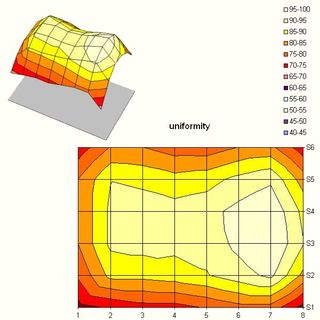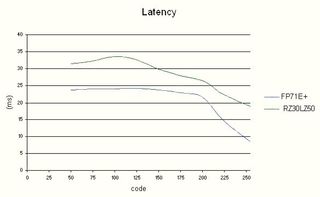I Want My 32" LCD TV
Spatial Uniformity
We measured spatial uniformity over the panel with our second sensor.
For those of you who aren't familiar with THG's testing methodology from our previous LCD TV tests, we set the panel at 50% brightness and 50% contrast and measured the uniformity of the lighting on a white image separated into 64 areas of equal size. The brightest point is considered to be 100%, and the previously measured black value is considered 0%, with the other values obtained distributed between them.

Here, the results were far from excellent. The values varied over a range of more than 25%. On the other hand, the difference in brightness between the upper and lower part of the panel was slight, the graph being symmetrical along the horizontal axis. Concretely, the implications for the viewer are visible above all in dark images. Good uniformity shows a perfect black image anywhere on the screen, whereas poor uniformity will show unsightly halos of light. That's a problem above all with movies.
LG RZ30LZ50: Latency Not Specified, But No Problem
Strange as that may seem, we were given no latency specifications on the panel. No brochure or Web page refers to the RZ30LZ50's latency. But of course we measured it for ourselves:

The curve shows the different latency values for different levels of gray. A black-white alternation is shown on the curve by a point at X-axis 255, a black-gray alternation produces a point at X-axis 125, a black-gray alternation shows as 50, etc.
The official ISO latency rating specified by the manufacturer is only for black/white transitions (0/255). While the value we measured agrees with the manufacturer on this point, it's not of much value in judging the actual responsiveness of the panel in practice.
Stay on the Cutting Edge
Join the experts who read Tom's Hardware for the inside track on enthusiast PC tech news — and have for over 25 years. We'll send breaking news and in-depth reviews of CPUs, GPUs, AI, maker hardware and more straight to your inbox.
As you can see, the results here were less than glorious. In the worst case the latency was 33 ms. That's still not too annoying when using a living-room DVD player, especially when you use progressive scan. But connected to a PC, the 33 ms value was noticeable with recent video games, which was a real shame.
Video Quality
The RZ30LZ50 boasts a Faroudja DCDi video processor. And it shows. The colors were good and bright, and the picture was sharp. The viewing angles claimed in the specs - 176/176 - are accurate. Regardless of the viewer's position, the RZ30LZ50 has remarkable image quality. The latency is a negative point, however. It shows up when screening movies - above all when using the S-Video input, oddly enough.
Interpolation
Unfortunately, interpolation is not this set's strong point. In 4/3 mode, images were good with video games on a console and screening DVDs. But as soon as we zoomed in, the images became jagged.
In fact, that was a disadvantage we were afraid we'd run into with large-diagonal TV sets. The larger the diagonal measurements of the screen, the bigger the pixels are for a given resolution. That means that the panel doesn't have the precision necessary for smoothing the image. Even if 26", 30" and 32" models often share the same scaling electronics, stair step effects are more difficult to compensate for as the screen diagonal increases. We got in touch with LG about this matter, and we were told that they're working on a new version of their TV sets with better interpolation, which was a smart decision to make on their part.
PC Mode
Connected to a PC, interpolation is a problem you can overcome provided you work in native resolution - 1280 x 768. The LG RZ30LZ50 operated very well connected to a PC via VGA or DVI. Unfortunately, the panel's latency remained a problem for this model, and it was visible when connected to a PC projecting 60 frames per second instead of 30. In video games, latency was a problem. The unit was perfectly playable, of course, but calling it a good gaming screen is another matter.
Sound Quality
Here again we were disappointed. The sound from the RZ30LZ50 was fairly muffled. You'll need an external home theater system.
Conclusion
Our impressions of the LG RZ30LZ50 are more than mixed. It's a nicely finished product and it has good, well-balanced colors, but its poor performance in terms of latency and scaling create a dilemma for the user: Should you connect the RZ30LZ50 to a DVD player and suffer from mediocre interpolation, or use a small form factor PC and get good interpolation performance but latency that's too perceptible? In any case, we're waiting expectantly for the new TV models from LG in the hope that these faults will be corrected.
Most Popular

